John G. Ramsay facts for kids
Quick facts for kids
John G. Ramsay
|
|
|---|---|

John Graham Ramsay
|
John Graham Ramsay (born June 17, 1931 – died January 12, 2021) was a famous British geologist. He was a professor at several universities, including Imperial College London, the University of Leeds, and the University of Zurich. He was known for studying how rocks change shape under pressure.
Contents
A Life Studying Rocks
John Graham Ramsay was born in London in 1931. He loved geology and earned his first degree in the subject in 1952 from Imperial College. He then continued his studies, earning a PhD in 1954. For his PhD, he studied rocks in the Scottish Highlands. He looked at how these rocks were bent and folded many times.
After serving in the military as a musician, he started teaching geology at Imperial College in 1957. He became a professor there in 1966. While at Imperial College, he wrote many important research papers. In 1967, he published his first book, Folding and Fracturing of Rocks. This book made him very well-known in the field of structural geology. Structural geology is the study of how rocks and Earth's crust get deformed.
Teaching and Research Around the World
From 1973 to 1976, Professor Ramsay led the Earth Sciences department at the University of Leeds. In 1976, he moved to Switzerland. He became a geology professor at the Eidgenössische Technische Hochschule (ETH) and the University of Zürich. He also received special honorary degrees from universities in France and Wales.
Professor Ramsay traveled a lot for his research. He studied rocks in South Africa and Zimbabwe. He also worked in Sudan, looking at the East African rift. He made important discoveries about the Alps and the Caledonian belt in Scotland.
Even after officially retiring from teaching geology, he kept doing research. He studied rocks in the Scottish Highlands. He also continued his love for music. He taught cello and chamber music in France. He even composed his own music.
John Ramsay wrote or co-wrote four books and many scientific papers. He believed that to understand how Earth's processes work, we must study real rocks. He thought that any ideas about how rocks change shape should always be compared with what we see in nature. This is why his papers often showed real rock examples.
Awards and Recognition
Professor Ramsay's work in structural geology earned him many awards. He received the Bigsby Medal in 1973 and the Wollaston Medal in 1986 from the Geological Society of London. He also won the Prestwich Medal in 1989 and the Sir Arthur Holmes Medal in 1984.
In 1992, he was made a Commander of the Most Excellent Order of the British Empire (CBE). This is a special honour given by the Queen of England.
He was also elected a Fellow of the Royal Society in 1973. This is a very high honour for scientists in the UK. He also became an honorary member of many other important scientific groups around the world. These included the Geological Society of America and the US National Academy of Sciences.
- 1973 Bigsby Medal
- 1986 Wollaston Medal
- 1984 Arthur Holmes Medal
Later Life
John Ramsay passed away in Zurich, Switzerland, on January 12, 2021. He was 89 years old.

